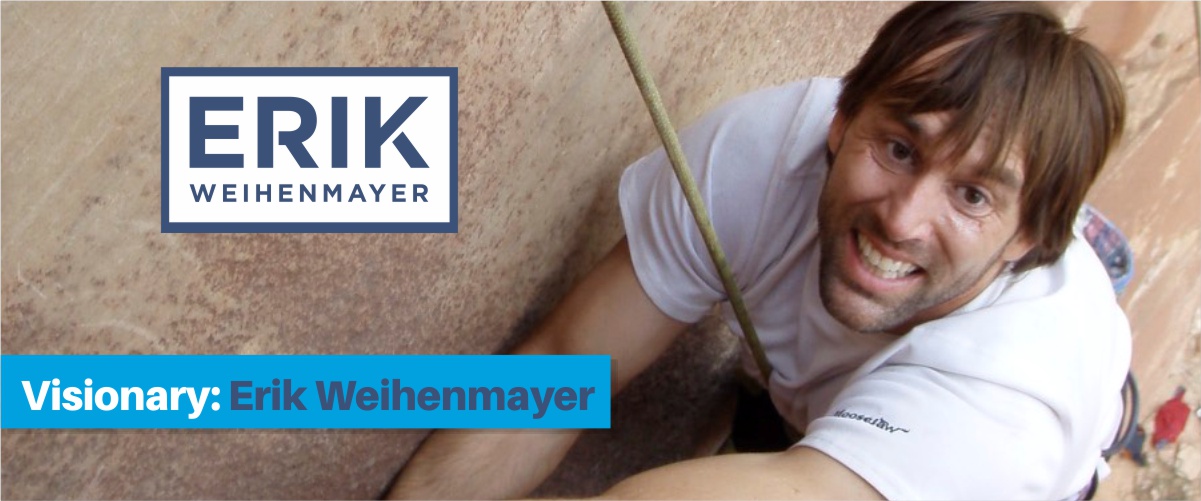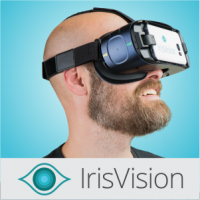Meet Low Vision Visionary Erik Weihenmayer

Some people climb a metaphorical Mount Everest every day of their lives. A select few climb the actual mountain. A few, very few, scale the summit of the world’s highest mountain without sight and the first to do so was Erik Weihenmayer. It’s one symbol of the life he lives with no barriers.
Why would someone without sight spend a week trekking to Everest Base camp, scale a 4,000-foot wall of glacial blue ice, traverse the South Col Death Zone, and then hike up the South Summit and Hillary Step where six breaths are required for each step? For Erik, it is both the reality and the symbolism of living a life with no barriers. “It takes people’s perceptions of what’s right and what’s possible and it shatters them into a million pieces,” said Erik. “Then when people have to rebuild their perceptions of what’s possible, it’s bigger.”
Erik lives his life breaking, expanding and reshaping people’s expectations of what it means to be blind or impaired in any way. He co-founded the non-profit No Barriers organization to spread the message of living a life without limitations. Some of the country’s largest corporations like Raytheon Corporation, Wells Fargo, Prudential, Ingersoll Rand, Phillips Healthcare, Coors Light and Cabinets to Go are supporting the No Barriers programs, including those for women, youth, and veterans.
“No Barriers” is a bit tongue in cheek. Erik clearly understands that the world is full of very real barriers for each individual. The point is to avoid living in the mental and emotional prisons that impairments and disabilities so often create. “’No Barriers’ is a rallying cry, a way to navigate our lives forward in a possibility-thinking way,” said Erik. “We need to understand the process of becoming the best version of ourselves. When we understand what the roadmap looks like, even though it may be messy, we are far better equipped to reach our destination.”
Erik knows about barriers. He lost his sight just before his freshman year in high school as the result of juvenile retinoschisis, a rare, genetic eye disease that affects mostly males and that splits the retina. He used a monocular to see, and then moved to “thick, bubble glasses, “placing his nose against books in order to read. He quickly developed a philosophy that he describes as “Get over yourself; lots of people have impairments and barriers, some you can see and some you can’t.”
Erik began carving out his own roadmap on the day he heard about a rock climbing class for the blind. He decided to check it out for himself and the rest is history. “For me it was understanding the element of pioneering, of finding the tools that would make me the very best I could be. There I was, a kid learning to use a cane and practicing mobility and then I lost my eyesight and I couldn’t play baseball anymore. I was introduced to an organization that offered and that affected my trajectory.”
Now Erik creates transformative experiences for people living with barriers, whether they are blind, deaf, in the foster care system, 1st generation Americans, veterans, living with physical injuries, in poverty, or have survived some type of trauma. He has led blind teenagers through the Grand Canyon and the Mountains of Peru and helped physically impaired veterans to scale sheer mountain walls.
For a man who has conquered what few sighted people will – climbing Mount Everest, solo kayaking the thunderous whitewater of the Colorado River, completing the Seven Summits by climbing the highest peak on each continent, the complex nuances of everyday life still prevent frustrating obstacles. It is still difficult to find coffee in an airport or bags at baggage claim. It is impossible to use a new microwave until tactile buttons have been added to the keypad.
“One day I was on my way to the gym and snow had covered the path I usually take. I couldn’t navigate it so I ended up walking off the path and found myself knee deep in a duck pond. I had lost the time to go work out.”
People with low vision or legal blindness aren’t going to become the first solo paraglider like Erik did – that title is taken. However, that doesn’t mean they can’t adopt the same spirit of adventure to broaden their lives. “It’s not about being a daredevil or an adrenaline junky,” Erik said. “It’s about challenging yourself to try new things every day. If you usually get rides from friends, take the bus one day. The challenge of doing something new means you are living.”
For each person who struggles with low vision or blindness, Erik has a message of motivation. “Don’t mistake comfort for fulfillment. If adversity and trauma are making you self-absorbed, do something to get outside yourself. Connect with other people to make the world better in some way.”
Erik is eternally optimistic about what human beings can achieve. “People have a light inside themselves that is trying to grow. When that light starts to dwindle people with disabilities can fall into places they don’t want to be. Adversity has its advantages. It’s like campers vs. climbers; campers settle and climbers challenge themselves. Don’t just be happy that you aren’t starving or falling downstairs. Pursue that messy map that will take you to a higher, better, happier version of yourself – the best that you can be.”
Erik’s newest book No Barriers, is the story of his life after his record-setting climb of Mount Everest. It tells the story of his expeditions around the world with blind Tibetan teenagers, helping soldiers climb their way home from war, kayaking the Grand Canyon, and adopting a son from Nepal. Find out more on Erik’s website (touchthetop.com) and learn how he transcends personal barriers to show others a way forward.




